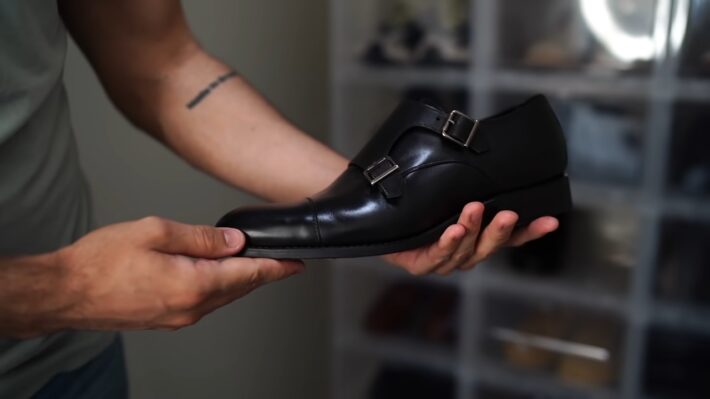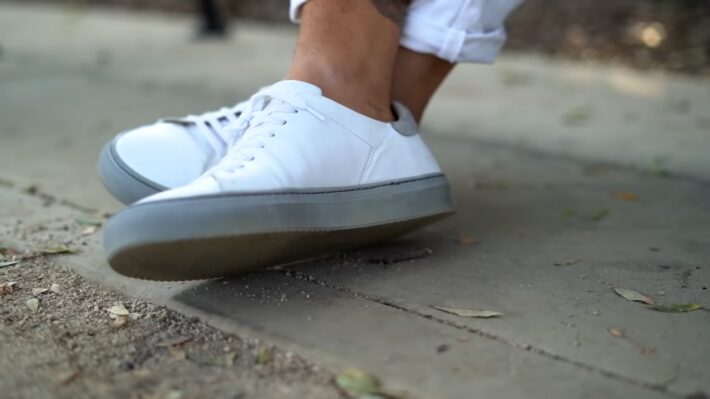It’s not new knowledge that feet come in different sizes. If you retail or intend to retail male footwears, it can be overwhelming to have all sought of feet walk into your store to get their fitting sizes.
So, if you are a new retailer of male footwears, or you intend to venture into the business, or maybe you simply wish to satisfy your curiosity by getting an answer to “what are the most common shoe sizes for men?”, I’ll try my very best to help you in this article.
For starters,
Shoe sizes are determined according to metrics. The most common metrics are US, UK, EU, and Japan. I’ll be relying on the US metric and its UK/EU equivalent.
So, generally, the most common shoe sizes for men, according to the US metric (with its UK and EU equivalent) are:
| US | UK equivalent | EU equivalent |
| Size 9 | 8 | 42 |
| Size 9.5 | 8 ½ (8.5) | 42 ½ (42.5) |
| Size 10 | 9 | 43 |
| Size 10.5 | 9 ½ (8.5) | 43 ½ (43.5) |
| Size 11 | 10 | 44 |
But you need to read further.
Though these sizes are generally the most common shoe sizes for men, I believe that certain factors play a role in determining whether these applies universally, or in all cases.
If you are a footwear retailer, or you intend to be one, you need every useful information that will enable you stock up the shoe sizes that will fit majority of your customers.
So, pay attention to the observations I’m about to make.
Average Male Height in a Geographic Region
I believe that the average male height within a geographic region plays a role in determining whether the most common shoe sizes for men, indicated above, truly apply within the region.
And yes, I believe that there is a correlation between height and shoe size. I mean, it is often the case that a person’s shoe size is proportionate to the person’s height.
Obviously, a 6ft and beyond male is likely to be endowed with larger or longer feet length, than a 5ft 5-inch man.
So, if the correlation between a person’s height and shoe size is considered, then the most common shoe sizes for men will definitely differ between geographic regions.
And studies have shown that the average male height differs from one geographic region to another.
Some regions are known to have very tall males, recording an average male height of 5ft 10 ½ inch – 5ft 11 ½ inch. For example, Slovakia, Serbia, Austria, Belgium, Denmark, Latvia, Netherlands, Finland, Poland, Slovakia, Sweden and some other nations record really tall traits among their citizens.
In regions like the US, UK, Russia, Australia, Israel, and Italy, an average male height of 5ft 9 inch – 5ft 10 inch has been recorded.
In some African countries, Asia, and regions like the Philippines and Indonesia, average male heights ranging from 5ft 2inch – 5ft 8 inches have been recorded.
So, considering the differences in average male height within regions, it will not be wrong to infer that the most common shoe sizes for men in regions with average male heights of 5ft 2inch – 5ft 8inch will fall within these ranges:
| US | UK equivalent | EU equivalent |
| Size 5 – 5.5 | 4 – 4.5 | 38 |
| Size 6 – 6.5 | 5 – 5.5 | 39 – 39.5 |
| Size 7 – 7.5 | 6 – 6.5 | 40 – 40.5 |
| Size 8 – 8.5 | 7 – 7.5 | 41 – 41.5 |
| Size 9 | 8 | 42 |
| Size 9.5 – 10 | 8.5 – 9 | 42.5 – 43 |
This is because, the foot length of the majority of the male folks within these regions are not likely to be too large.
Also, it is not uncommon to find that in regions with average male height ranging from 5ft 11inch and above, the most common shoe sizes for men within such region will likely include US size 11.5 & 12, which are the equivalent of UK 10.5 and 11, and EU sizes 44.5 and 45.
Brand Sizing
In the course of testing a new shoe from a new brand, you may have observed that the shoe size, which should ordinarily have been the right fit for your feet, may be slightly bigger, or in some cases, slightly smaller.
If you have gone through such an experience, it obviously did not mean that your feet reduced or increased in shape at the time you tried on the new shoe. Rather, it reveals that brand sizing differs.
The variations depend on two things.
- Lack of standardization amongst brands. For example, the foot length measurement for a US size 9 Adidas is different from the foot length measurement for a US size 9 Nike.
- The difference in country metrics.
I will use three different brands to illustrate what I’m trying to say. So, for example, Adidas men shoes chart has the following metrics and foot length measurements:
| Foot Length (CM) | US | UK equivalent | EU equivalent |
| 27cm | Size 9 | 8.5 | 42 2/3 (42.7) |
| 27.5cm | Size 9.5 | 9 | 43 1/3 (43.3) |
| 28cm | Size 10 | 9.5 | 44` |
| 28.5cm | Size 10.5 | 10 | 44 2/3 (44.7) |
| 29cm | Size 11 | 10.5 | 45 1/3 (45.3) |
On the other hand, Nike men shoes chart, shows the following metrics and foot length measurements:
| Foot Length (CM) | US | UK equivalent | EU equivalent |
| 26.2cm | Size 9 | 8 | 42.5 |
| 26.7cm | Size 9.5 | 8.5 | 43 |
| 27.1cm | Size 10 | 9 | 44 |
| 27.5cm | Size 10.5 | 9.5 | 44.5 |
| 27.9cm | Size 11 | 10 | 45 |
Another example, Allen Edmonds men shoes chart shows the following metrics and foot length measurement:
| Foot Length (CM) | US | UK equivalent | EU equivalent |
| 26.2cm | Size 9 | 8.5 | 43 |
| 26.7cm | Size 9.5 | 9 | 43.5 |
| 27.1cm | Size 10 | 9.5 | 44 |
| 27.5cm | Size 10.5 | 10 | 44.5 |
| 27.9cm | Size 11 | 10.5 | 45 |
After taking a good look at these charts, you’ll agree with me that the following facts are apparent:
- These brands have slightly different UK and EU equivalents to the general men shoe size chart that I indicated at the beginning of this article.
- The first two brands have slightly different foot length measurements.
Going by this information, and for the purpose of ensuring that you fully comprehend the point I’m trying to make, I’ll simply make some illustrations here:
- On the basis of metrics, a UK size 9 Adidas, is a UK size 8.5 Nike.
- The foot length for a US size 9 Adidas, will likely fit into a US size10 Nike.
- By metrics, a UK size 43 Nike, is a UK size 43.5 Allen Edmonds.
- A 27.5cm foot length will fit into a US size 9.5 Nike but will fit into a US size 10, Allen Edmonds.
It’s quite a tricky right.
This explains why shoe shopping can sometimes be a frustrating journey.
So, what does this variation in brand sizes and metrics imply?
Well, I’ll say that before making a purchase, it’s important that you look up the company’s men shoes chart in order to be properly guided,
Don’t just assume that a US size 10 Allen Edmond’s would be the same as a US size 10 Johnston & Murphy (or any other footwear). I mean, you’ve seen from the charts that a US size 10 Nike is definitely not the equivalent of a US size 10 Adidas.
I know that looking up a brand’s shoe chart may not guarantee a 100% accuracy of getting the right fit, especially when making personal online purchases, but I believe that it is still reasonable to do so.
Shoe Type
I’m sure that you must have observed that your sneaker size is usually one to two inches bigger than the size of your dress shoe. Same also applies to men boot sizes
This makes me come to the conclusion that sneakers and boot sizes are usually modeled slightly bigger than the equivalent of their dress shoe sizes (even though this does not apply in all cases).
If you don’t get the drift yet,
What I’m trying to say is that a person who fits into US size 10 sneakers, would likely fit into a US size 9 dress shoe.
If this is true, which I believe it is in most cases, the most common men’s sneaker sizes may slightly differ from the most common shoe sizes I indicated earlier in this article.
Well, that’s quite a read, but I’ll like to add one more thing.
A US size 9D is different from a US size 9E. And, I really don’t mean to confuse you.
So, for the purpose of creating extra awareness, especially for those who are considering a business in shoe retail and for those who are new in the business, the next information is equally vital.
Shoe Width
You would literally see the above spicy combinations of feet:
- Short and wide feet
- Short and narrow feet
- Very long and narrow feet
- Long and wide feet (Big feet)
Some shoe brands produce shoe sizes that come in different widths, in order to cater for the variations in foot width.
There is no standardization in the width of alphabetical indications. For example, a brand may produce 43D, 43E, 43F, 43G. Another brand may indicate, 43XL, 43XXL, 43XXXL.
The lack of standardization should not bother you. The higher the alphabet, the wider the feet.
So, if a shoe brand produces shoe sizes in different widths, and you wish to purchase shoes for your retail, try as much as possible to buy the shoe sizes in their different widths.
I sincerely hope I did not end up confusing you, because all I’ve been trying to say is this:
- There are generally shoe sizes that are considered the most common shoe sizes for men.
- But these general sizes may not apply universally, because the average height in a geographic location may play a great role in determining the common shoe size within an area.
- Brand sizing and type of shoe also complicate the size list a bit.
- So, when you set out to purchase the general sizes I have mentioned, please pay attention to the height within your location, brand sizing, shoe type, and shoe width.



